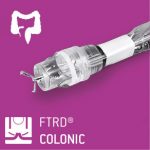EFTR for small T1CRC: FTRD® shows high R0 resection and low cancer recurrence
Medium-term outcomes of EFTR for small T1CRC: FTRD® achieves high R0 resection and demonstrates low cancer recurrence
The analysis of all consecutive EFTR procedures for suspected T1CRC with adenocarcinoma from the Dutch colorectal FTRD registry shows that EFTR is an effective primary treatment for T1CRC ≤2cm. R0 resection rates were high for both superficial (92.9%) and deep (87.0%) T1CRC. Furthermore, the procedure allows organ-preserving treatment with low cancer recurrence rates over a median follow-up of 39.5 months.
Endoscopic full-thickness resection (EFTR) is a minimally invasive treatment option for smaller-sized (≤2cm) T1 colorectal cancer (T1CRC). At the UEG Week 2023 in Copenhagen, Denmark, Albers et al. presented a study on EFTR for T1CRC with the aim to evaluate the medium-term oncological outcomes.
For the analysis, all consecutive first-line EFTR procedures for suspected T1CRC with adenocarcinoma from the Dutch prospective colorectal EFTR registry (involving 19 centres between November 2015 and January 2023) were evaluated. The outcomes assessed included R0 resection rate (≥0.1mm free margin), cancer recurrence, 3-year disease-free survival (DFS), and 3-year overall survival (OS).
A total of 320 patients were included (median age 70 years, 62% male, median lesion, and specimen size 14.7mm and 27.0mm), with 241 (75.3%) patients diagnosed with pT1 CRC. Of the 241 pT1, 60/241 (24.9%) were superficial submucosal invasive cancer (S-SMIC) and 171/241 (71.0%) were deep submucosal invasive cancer (D-SMIC); 9/241 (3.7%) were inconclusive. R0 resection was achieved in 87.9% of pT1 cases, with similar rates for S-SMIC (92.9%) and D-SMIC (87.0%). R0 resection for pT1 lesions sized ≤15mm and 16-20mm was similar (89.3% vs 86.7%; p=0.820). No significant difference in R0 resection for colon vs rectum was found (89.5% vs 81.0%; p=0.126). High-risk features were present in 23/60 (38.3%) of S-SMIC cases and 109/171 (63.7%) of D-SMIC cases. Completion surgery was performed in 40.4% (51/136) of these high-risk cases, with nodal metastasis found in 11.8% (6/51); all had risk factors ≥2. In the low-risk D-SMIC group, completion surgery was not performed in most cases (60/65 (92.3%)). Follow-up data was available for 174/241 (72.1%) of pT1 patients (median follow-up of 39.5 months; IQR 27.3) with low rates of cancer recurrence observed. The follow-up cohort was divided into a high-risk pT1 surveillance group (n=66), a low-risk pT1 surveillance group (n=72) and a pT1 CS group (n=36). 3-year DFS and 3-year OS were 95.6% and 83.4% for the high-risk pT1 surveillance group, 97.2% and 92.6% for the low-risk pT1 surveillance group, 98.2% and 100% for the pT1 CS group.
This data/analysis shows that EFTR is an effective primary treatment for suspected T1CRC ≤2cm, achieving high R0 resection rates for both S-SMIC and D-SMIC. The procedure allows for organ-preserving treatment and demonstrates low cancer recurrence rates over a median follow-up of 39.5 months.
Albers SC, Zwager L, van der Spek BW, Schreuder R-M, Perk L, Weusten BLAM, Boonstra JJ, van der Sluis H, Schwartz MP, Vlug MS, Wientjes C, Rando Munoz FJ, Nagengast WB, Bekkering F, ten Hove R, Terhaar sive Drost JS, Houben M, Seerden TCJ, de Wijkerslooth T, Gielisse E, Fariña Sarasqueta A, Fockens P, Dekker E, Bastiaansen BAJ, Dutch eFTR Study Group. Medium-term oncological outcomes following endoscopic full-thickness resection for T1 colorectal cancer: results from the Dutch prospective eFTR registry. Abstract Session “Advanced endoscopy for early CRC: The final answer?” OP034. UEG Week 2023 (October 14-17), Copenhagen, Denmark.
 |
 |


 Deutsch
Deutsch  Français
Français 